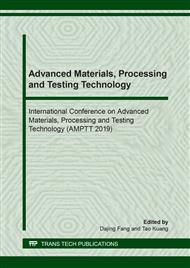[1]
R.A. Phillips, S.L. Cooper, Phase separation in crystallizable multiblock poly (ether-ester) copolymers with poly (tetramethylene isophthalate) hard segments, Polymer. 35 (1994) 4146-4155.
DOI: 10.1016/0032-3861(94)90589-4
Google Scholar
[2]
J.W.C. Van Bogart, A. Lilaonitkul, S.L. Cooper, Morphology and properties of segmented copolymers, American Chemical Society: USA,1979, pp.3-30.
DOI: 10.1021/ba-1979-0176.ch001
Google Scholar
[3]
Y. Camberlin, J.P. Pascault, Quantitative DSC evaluation of phase segregation rate in linear segmented polyurethanes and polyurethaneureas, J. Polym. Sci., Part A: Polym. Chem. 21 (1983) 415-423.
DOI: 10.1002/pol.1983.170210211
Google Scholar
[4]
R. Bonart, E.H. Müller, Phase separation in urethane elastomers as judged by low-angle X-ray scattering. I. Fundamentals, J. Macromol. Sci., Part B: Phys. B10 (1974) 177-189.
DOI: 10.1080/00222347408219403
Google Scholar
[5]
T.P. Russel, J.S. Lin, S. Spooner, G.D. Wignall, Intercalibration of small-angle X-ray and neutron scattering data, J. Appl. Crystallogr. 21 (1988) 629-638.
DOI: 10.1107/s0021889888004820
Google Scholar
[6]
E. Yilgör, I. Yilgor, E. Yurtsever, Hydrogen bonding and polyurethane morphology. I. quantum mechanical calculations of hydrogen bond energies and vibrational spectroscopy of model compounds, Polymer. 43 (2002) 6551-6559.
DOI: 10.1016/s0032-3861(02)00567-0
Google Scholar
[7]
S. Sami, E. Yildirim, M. Yurtsever, et al, Understanding the influence of hydrogen bonding and diisocyanate symmetry on the morphology and properties of segmented polyurethanes and polyureas: computational and experimental study, Polymer. 55 (2014) 4563-4576.
DOI: 10.1016/j.polymer.2014.07.028
Google Scholar
[8]
E. Yilgör, E. Burgaz, E. Yurtsever, I. Yilgör, Comparison of hydrogen bonding in polydimethylsiloxane and polyether based urethane and urea copolymers, Polymer. 41 (2000) 849-857.
DOI: 10.1016/s0032-3861(99)00245-1
Google Scholar
[9]
C. Akduman, I. Özgüney, E.P.A. Kumbasar, Preparation and characterization of naproxen-loaded electrospun thermoplastic polyurethane nanofibers as a drug delivery system, Mater. Sci. Eng., C. 64 (2016) 383-390.
DOI: 10.1016/j.msec.2016.04.005
Google Scholar
[10]
W.P. Yang, Phase separation dynamics in polyurethane reaction injection molding, Ph.D. Thesis, University of Minnesota, Minneapolis (1987).
Google Scholar
[11]
N. Luo, D.N. Wang, S.K. Ying, Infrared spectral analysis of hydrogen bonding in polyurethane, China Synthetic Rubber Industry. 18 (1995) 200-203.
Google Scholar
[12]
I. Yilgör, E. Yilgör, G.L. Wilkes, Critical parameters in designing segmented polyurethanes and their effect on morphology and properties: a Comprehensive Review, Polymer. 58 (2015) 1-36.
DOI: 10.1016/j.polymer.2014.12.014
Google Scholar
[13]
N. Luo, D.N. Wang, S.K. Ying, Hydrogen bonding of polyether poly (urethane urea)s, Polymer Bulletin. (1998) 37-43.
Google Scholar
[14]
H.W. Zhu, Analysis of organic molecular structure spectrum, Chemical Industry Press: Beijing, 2005, pp.38-44.
Google Scholar
[15]
C.P. Christenson, M.A. Harthcock, M.D. Meadows, et al, Model MDI/butanediol polyurethanes: molecular structure, morphology, physical and mechanical properties, J. Polym. Sci., Part B: Polym. Phys. 24 (1986) 1401-1439.
DOI: 10.1002/polb.1986.090240703
Google Scholar
[16]
C.S.P. Sung, N.S. Schneider, Infrared studies of hydrogen bonding in toluene macromolecules diisocyanate based polyurethanes, Macromolecules. 8 (1975) 68-73.
DOI: 10.1021/ma60043a015
Google Scholar
[17]
N. Luo, D.N. Wang, S.K. Ying, Spectral and thermal analyses of polyurea based on MDI and DETDA, China Synthetic Rubber Industry. 20 (1997) 25-28.
Google Scholar
[18]
H. Ishihara, I. Kimura, K. Saito, H. Ono, Infrared studies on segmented polyurethane-urea elastomers, J. Macromol. Sci., Part B: Phys. 10 (1974) 591-618.
DOI: 10.1080/00222347408219408
Google Scholar
[19]
K. Nakayama, T. Ino, I. Matsubara, Infrared spectra and structure of polyurethane elastomers from polytetrahydrofuran, diphenylmethane-4,4'-diisocyanate and ethylenediamine, J. Macromol. Sci., Part A: Pure Appl. Chem. 3 (1969) 1005-1020.
DOI: 10.1080/10601326908051929
Google Scholar
[20]
N. Luo, D.N. Wang, S.K. Ying, Microphase separation study of a segmented poly(urethane urea) copolymer by IN-SITU FTIR, Acta Polymerica Sinica. (1996) 423-428.
Google Scholar
[21]
T. Yamamoto, M. Shibayama, S. Nomura, Structure and properties of fatigued segmented poly (urethaneurea) s Ⅲ. Quantitative analyses of hydrogen bond, Polym. J. 21 (1989) 895-903.
DOI: 10.1295/polymj.21.895
Google Scholar
[22]
H.K. Lee, S.W. Ko, Structure and thermal properties of polyether polyurethaneurea elastomers, J. Appl. Polym. Sci. 50 (1993) 1269-1280.
DOI: 10.1002/app.1993.070500718
Google Scholar
[23]
C.B. Wang, S.L. Cooper, Morphology and properties of segmented polyether polyurethaneureas, Macromolecules. 16 (1983) 775-786.
DOI: 10.1021/ma00239a014
Google Scholar
[24]
L. Born, H. Hespe, On the physical crosslinking of amine-extended polyurethane urea elastomers: a crystallographic analysis of bis-urea from diphenyl methane-4-isocyanate and 1, 4-butane diamine, Colloid & Polymer Science. 263 (1985) 335-341.
DOI: 10.1007/bf01412250
Google Scholar
[25]
L. I. Maklakov, G. G. Suchkova, Quantum chemistry studies of far-infrared spectra of aromatic urethanes, Spectrochim. Acta, Part A. 71 (2008) 238-244.
DOI: 10.1016/j.saa.2007.12.009
Google Scholar
[26]
S. H. Zhang, X.J. Song, Y.H. Li, X.H. Tan, Y.G. Wang, 1-(2,6-Difluorobenzoyl)-3-(1,3,4-thiadiazol-2-yl)urea, Acta Crystallogr., Sect. E: Crystallogr. Commun. 61 (2005) 2360-2362.
DOI: 10.1107/s1600536805020362
Google Scholar
[27]
M. A. Harthcock, Probing the complex hydrogen bonding structure of urethane block copolymers and various acid containing copolymers using infrared spectroscopy, Polymer. 30 (1989) 1234-1242.
DOI: 10.1016/0032-3861(89)90041-4
Google Scholar
[28]
Z. S. Chen, W.P. Yang, C.W. Macosko, The study of polyurethanes and polyureas by transmission spectra of Fourie transform infrared spectroscopy, Polymeric Materials Science and Engineering. (1993) 58-62.
Google Scholar


